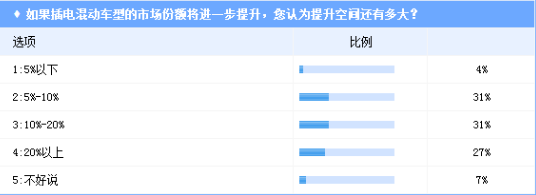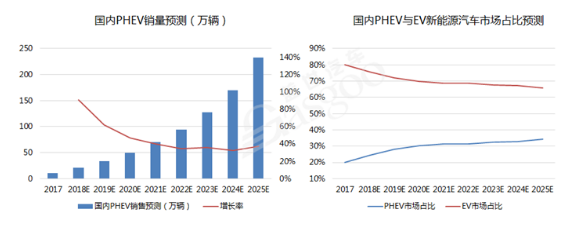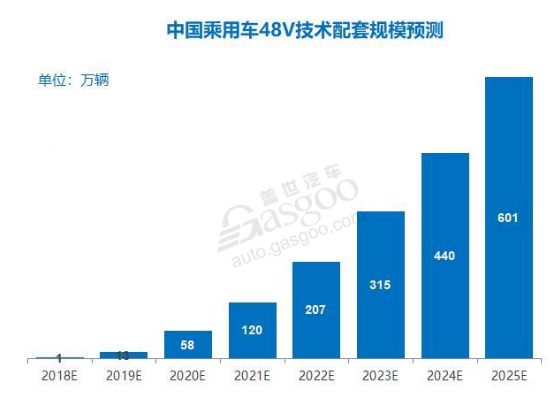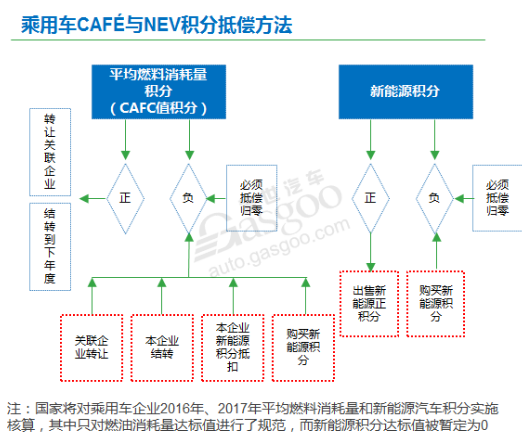Pure electric vehicles and plug-in hybrid vehicles are the two main forces in the current new energy vehicle market, which not only jointly promote the development of this market, but also compete with each other. At present, pure electric vehicles have always been the main sales force of new energy vehicles, occupying an absolute advantage, and plug-in hybrids are not reconciled, and continue to squeeze the market share of pure electric vehicles. According to the China Insurance Regulatory Commission's new vehicle traffic compulsory insurance data, in 2017, the retail volume of hybrid vehicles was 93,549, accounting for about 18% of the total retail sales of new energy vehicles (527,194) that year; the retail volume of pure electric vehicles was 433,595 , Accounting for about 82% of the total. In the first half of 2018, the retail volume of plug-in hybrid models reached 78,957, accounting for about 29% of the total; the retail volume of pure electric vehicles was about 189,332, accounting for about 71%. It can be seen that the share of plug-in hybrid models in the new energy vehicle market has increased significantly. So, what is the reason behind the market performance of plug-in hybrid models? Will the market share of this segment increase further in the future? How much room for improvement? In this article, the author will analyze and discuss the above issues based on recent related research. Recently, the editor has conducted a survey on the question "What do you think are the main reasons for the increase in the share of plug-in hybrid vehicles?" The results show that nearly 50% of participants believe that the main reason for the increase in the share of plug-in hybrid models is that it has "relatively small dependence on batteries." Of course, this is relative to pure electric vehicles. As we all know, pure electric vehicles rely heavily on batteries. At present, batteries still have some shortcomings in terms of charging and discharging performance, safety, etc. The infrastructure such as charging piles is not perfect, and the cruising range has not been relatively large. Breakthrough, which will obviously affect consumers’ enthusiasm for buying. The plug-in hybrid model is different. In addition to the policy support of subsidies, license plates, and rights of way with pure electric models, it is relatively less dependent on batteries, does not rely on charging piles, and also avoids users' cruising range anxiety. As mentioned earlier, the current pure electric and plug-in hybrid models have government subsidies, but their subsidies are different. In 2018, the latest subsidy policy adjusted the subsidies of the two respectively. Although the subsidy for pure electric models is still higher than that for plug-in hybrid models, compared with the relatively large change in the subsidy amount for pure electric models, the subsidy for plug-in hybrid models is relatively stable. According to the policy, the national subsidy for plug-in hybrid models will be adjusted from 24,000 yuan/vehicle in 2017 to 22,000 yuan/vehicle in the second half of the year, and the national subsidy will only be reduced by 2,000 yuan, which will have a limited impact on the sales of plug-in hybrid models. It can also be found in this survey that 13% of participants agree with this view. However, relative to the impact of subsidies, more participants believe that the increase in cost performance has a greater impact on the increase in the share of plug-in hybrid models, with 33% of participants choosing this option. Since plug-in hybrid models do not need to carry a large number of batteries like pure electric models, and with the improvement of product technology, the cost of plug-in hybrid models has been better controlled. Relevant analysts from Gasgoo Research Institute said that the cost and economy of plug-in hybrid models are gradually approaching traditional cars. According to information released by relevant media, in March this year, BMW Brilliance launched a new 5-series plug-in hybrid model, priced at 498,900 yuan before the subsidy. Compared with the direct price cut of the old model in 2015 by nearly 200,000 yuan, the sales price of the same level of fuel vehicles is almost the same. Even with the exemption of purchase tax and subsidies for new energy vehicles, the price of the new 5-series plug-in hybrid model is lower than that of the fuel version. Regardless of the significance of BMW Brilliance’s move, such a price cut at least proves that the price of plug-in hybrid models is capable of competing with traditional fuel vehicles. In addition, it is worth noting that 8% of the participants in the survey believe that the sharp decline in the sales of A00-class pure electric models is also one of the reasons behind the market performance of plug-in hybrid models. At present, most of the domestic sales of pure electric vehicles come from A0 and A00 grade products. According to the new subsidy policy, the A00 grade is almost completely restricted below the subsidy line. Affected by this, the sales of A00-class pure electric vehicles in June this year fell by 25% year-on-year, and under this subsidy policy, the downward trend is likely to continue. From the above content, it is not difficult to conclude that the market performance of plug-in hybrid models is not accidental. Due to several major factors that will continue to exist in the future, it is foreseeable that the market share of plug-in hybrid models will further increase in the future. In the survey results on the question “Do you think the market share of plug-in hybrid vehicles will be further increased in the future?†It was found that although 9% of the participants chose “noâ€, 90% of the participants believed this One market share will continue to increase further. In addition, from the survey results of "If the subsidy is cancelled, would you rather buy a pure electric vehicle or a plug-in hybrid vehicle?", although 10% of the participants are not interested in either of these, the remaining 90% of the participants Among those, 77% prefer to choose plug-in hybrid vehicles, and only 13% choose pure electric vehicles. This also verifies the above conclusion again. However, the increase in share is one thing, and how much it can increase is another. This represents how much market potential it has. As can be seen from the survey results in the figure below, nearly 90% of participants believe that the market share of plug-in hybrid models has more than 5% room for improvement, and 31% of them believe that the proportion of this model in the new energy vehicle market will increase by 5%. -10%, 31% think it is between 10% and 20%, and 27% of the participants think it is above 20%. In this way, the expected value of the plug-in hybrid model is still very high. A set of data previously shared by BYD President Wang Chuanfu shows that the sales of new energy vehicles in Europe in 2017 were 259,000. According to the type of fuel, the ratio of pure electric and plug-in hybrid vehicles is close to 1:1. Pure electric vehicles are 51%, plug-in power is 49%. In 2017, the sales of new energy vehicles in the US market was 195,200, and pure electric vehicles were more than 100,000 units, accounting for 53%. There were more than 90,000 plug-in hybrids, accounting for Up 47%. With reference to these two major markets, there is still room for growth in domestic plug-in hybrid models in the future. According to the relevant predictions of Gasgoo Automotive Research Institute, the domestic plug-in hybrid vehicle market will maintain a growth trend. Although the market growth rate will slow down after 2018, its proportion will continue to increase. It is expected that the plug-in hybrid vehicle will remain at 35 percent around 2025. %-40% of the new energy vehicle market share. It can be seen that because plug-in hybrid models still enjoy subsidies, under the "double points" policy, they will still occupy a certain proportion of new energy vehicle points. Autonomous car companies such as Geely and Changan have launched new plug-in hybrid products, and foreign-funded enterprises also Expanded the corresponding layout. In the long run, pure electric vehicles are the trend, but due to technical and infrastructure limitations in the short term, plug-in hybrid vehicles will be a better alternative. Of course, at the same time, there are also some "uncertainty factors" affecting the intermixing market, bringing certain risks to its future development. Looking at the automobile market in the past two years, while the development of pure electric and plug-in hybrid vehicles, the growth momentum of general hybrid electric vehicles and 48V light hybrid vehicles has also been quite rapid. Taking 48V light hybrid as an example, Gasgoo Automotive Research Institute believes that the pressure of higher fuel consumption regulations in the next few years will promote the gradual formation of the production capacity layout of 48V technology component suppliers, and many new 48V technology vehicles represented by European brands will be launched on the market. Driven by, it is estimated that the global 48V technology supporting scale of passenger cars is expected to exceed 14 million in 2025, while the Chinese market is expected to exceed 6 million. In the future, as general hybrid vehicles and 48V light hybrid vehicles continue to grow, the market share of pure electric and plug-in hybrid vehicles will be squeezed to a certain extent. Under the "dual points" policy, plug-in hybrid models will still occupy a certain percentage of new energy vehicles. However, according to the specific regulations, as long as a pure electric vehicle has a cruising range of 200 kilometers, it can get 3.2 points. If the power consumption per 100 kilometers meets certain conditions, the points can be multiplied by 1.2. That is 3.84 points, while the plug-in hybrid model has only 2 points for a car, and it has high requirements for the pure electric cruising range, the energy efficiency of the pure electric, and the fuel consumption in the hybrid mode. In this case, compared to plug-in hybrid models, car companies may tend to focus more on pure electric models. In addition, according to the "Automobile Industry Investment Management Regulations (Draft for Comment)", plug-in hybrid models are assigned to fuel vehicle investment projects. Although this does not mean that plug-in hybrid models are excluded from the scope of new energy vehicles, according to the regulations , The fuel vehicle project was judged to be a prohibited investment project. This means that only those OEMs that have a license to produce fuel vehicles can make plug-in hybrid models. As mentioned earlier, under the dual-point policy, car companies may focus more on pure electric models. As a result, the situation of plug-in hybrid models is not optimistic. It is also worth noting that in order to deal with environmental pollution and solve the problem of traffic congestion, Beijing, Tianjin, Shanghai and other places have restricted the purchase of vehicles through license plate lottery and auction. Some cities have introduced vehicle tail number restriction policies, and for new energy vehicles , The state encourages unlimited purchases. This is a big plus for plug-in hybrid models. However, the relevant analysts of Gasgoo Research Institute believe that this will also bring risks to it. With the intensification of traffic congestion and the number of new energy license plate applicants soaring to a certain extent, if the country chooses to implement measures such as license plate control, this market It will also usher in great challenges. OVNS Max Vape is so convenient, portable, and small volume, you just need to take them ovns max vape bar,ovns max vape pen,ovns max vape device,ovns max vape disposable,ovns max vape puff Ningbo Autrends International Trade Co.,Ltd. , https://www.supermosvape.com





out of your pocket and take a puff, feel the cloud of smoke, and the fragrance of fruit surrounding you. It's so great.
We are the distributor of the ovns & vapeak vape brand, we sell ovns disposable vape,ovns vape kit, ovns juul compatible refillable pod, and so on.
We are also China's leading manufacturer and supplier of Disposable Vapes puff bars, disposable vape kit, e-cigarette
vape pens, and e-cigarette kit, and we specialize in disposable vapes, e-cigarette vape pens, e-cigarette kits, etc.